Holly Thompson's Blog, page 28
June 1, 2013
COETAIL--Flash Fiction and Student-created "Textbooks"
A post toward obtaining my Certificate in Educational Technology and Information Literacy (COETAIL)
In the recent COETAIL class, one question asked of participants was, "Can we have our students find/analyze/create up-to-the minute textbooks for our classes? How would this change the dynamic of the classroom?"
Courses in the arts, including creative writing, have long tended to be fairly student-centered. I recall a version of this approach pre-Internet at NYU's Creative Writing Program in a Craft of Fiction course in which the professor asked students to create the syllabus list of contemporary novels to be read that semester and to take turns leading the discussions in teams each week. There was no set list of texts. There was no textbook. Students determined the content and direction and challenge level of the course with guidance from the professor.
I'd love teach a course in which students create "textbooks" for a literature class or creative writing class--this could work for various age and ability levels, for different genres, online or face to face. I can envision projects, units or entire terms. Mulling this over, I came up with this example of a Flash Fiction lit/creative writing class:
For this course in flash fiction students would start by searching for information on the genre, defining the genre, its history, characteristics, and trends, and searching for flash fiction stories online, as well as links to print anthologies of flash fiction or literary journals that regularly feature flash stories. The information and resources would be shared among classmembers and with the public via social media tools. Next, the course would have students selecting a set number of flash stories to read from the resources, then sharing and commenting on the stories they selected, as well as commenting on stories selected by classmates. After that, students would create flash stories of their own, gathering feedback on drafts, revising and editing. Finally, the class collection of stories would be disseminated to the public as a group publication, performance of readings, blog posts, podcasts, audio anthology (such as a school version of Grub Street's The Drum ), video readings, or other format.
So where's the textbook in all this? A resulting student-created textbook chapter? A final ebook with the resources, comments and class-created flash stories? Or is a "textbook" really needed at all?
In March an EdCampColumbus a conference session was titled Textbooks are Dead, People: The Relevance of Student Created Ebooks in the Common Core (here is the Storify of tweets on the session with some interesting links). And I like Shawn McCusker's textbook project, described in The Textbook is Dead, Long Live the Textbook! What 1:1 is doing to Traditional Classroom Resources.
One reason for having a textbook is convenience, to save teachers and students from busywork and from having to reinvent the wheel each year, so perhaps my flash fiction project or course would be begun by one student group and further built on in a following semester or year by other student groups. Perhaps students would be creating a textbook chapter. Or perhaps, we are simply moving toward crowd-sourced "textbooks." Or perhaps we should just shift our focus to resources and information.
In the recent COETAIL class, one question asked of participants was, "Can we have our students find/analyze/create up-to-the minute textbooks for our classes? How would this change the dynamic of the classroom?"
Courses in the arts, including creative writing, have long tended to be fairly student-centered. I recall a version of this approach pre-Internet at NYU's Creative Writing Program in a Craft of Fiction course in which the professor asked students to create the syllabus list of contemporary novels to be read that semester and to take turns leading the discussions in teams each week. There was no set list of texts. There was no textbook. Students determined the content and direction and challenge level of the course with guidance from the professor.
I'd love teach a course in which students create "textbooks" for a literature class or creative writing class--this could work for various age and ability levels, for different genres, online or face to face. I can envision projects, units or entire terms. Mulling this over, I came up with this example of a Flash Fiction lit/creative writing class:
For this course in flash fiction students would start by searching for information on the genre, defining the genre, its history, characteristics, and trends, and searching for flash fiction stories online, as well as links to print anthologies of flash fiction or literary journals that regularly feature flash stories. The information and resources would be shared among classmembers and with the public via social media tools. Next, the course would have students selecting a set number of flash stories to read from the resources, then sharing and commenting on the stories they selected, as well as commenting on stories selected by classmates. After that, students would create flash stories of their own, gathering feedback on drafts, revising and editing. Finally, the class collection of stories would be disseminated to the public as a group publication, performance of readings, blog posts, podcasts, audio anthology (such as a school version of Grub Street's The Drum ), video readings, or other format.
So where's the textbook in all this? A resulting student-created textbook chapter? A final ebook with the resources, comments and class-created flash stories? Or is a "textbook" really needed at all?
In March an EdCampColumbus a conference session was titled Textbooks are Dead, People: The Relevance of Student Created Ebooks in the Common Core (here is the Storify of tweets on the session with some interesting links). And I like Shawn McCusker's textbook project, described in The Textbook is Dead, Long Live the Textbook! What 1:1 is doing to Traditional Classroom Resources.
One reason for having a textbook is convenience, to save teachers and students from busywork and from having to reinvent the wheel each year, so perhaps my flash fiction project or course would be begun by one student group and further built on in a following semester or year by other student groups. Perhaps students would be creating a textbook chapter. Or perhaps, we are simply moving toward crowd-sourced "textbooks." Or perhaps we should just shift our focus to resources and information.
Published on June 01, 2013 21:56
May 30, 2013
Asian Festival of Children's Content (AFCC) 2013--Books, Friends and Desserts
I'm back home in Japan after the Asian Festival of Children's Content 2013 in Singapore. As always, there's a bit of post-AFCC let down after such a vibrant gathering of writers, illustrators, translators, editors, publishers, librarians and readers from all over Asia.
For the first year AFCC was held at the National Library Singapore. That pod way up top, amid flitting swallows, was where a number of events were held and where I gave my keynote talk.

This year I was speaking in the translation seminar, a new track for the conference, on editing stories in translation--reflecting on my experience with the Tomo anthology. This track was organized by translator Avery Fischer Udagawa and also featured Alexander O. Smith--both are Tomo story translators. How nice to meet Tomo fans from around Asia! See the full post on the Tomo blog.
 Tomo fans!The country of focus for AFCC 2013 was Malaysia (2014 will be India), so there was a Malaysia night celebration...
Tomo fans!The country of focus for AFCC 2013 was Malaysia (2014 will be India), so there was a Malaysia night celebration...
 with some amazing desserts.
with some amazing desserts.
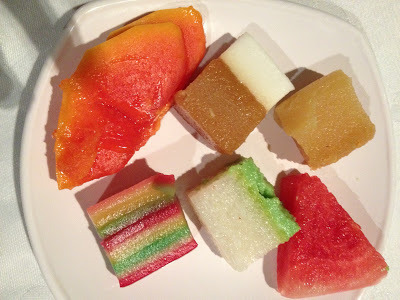
My keynote talk was Stories Set in Asia: Selling Them Overseas, including key questions agents and editors tend to ask.

Not long after the keynote was a launch celebration for The Language Inside outside in the plaza. Thanks to Bookaburra Books of Singapore for handling book sales for all of my books.

On the first evening of the Writers and Illustrators Conference at AFCC, the Singtel Asian Picture Book Awards and the Hedwig Anuar Children's Book Awards were announced.
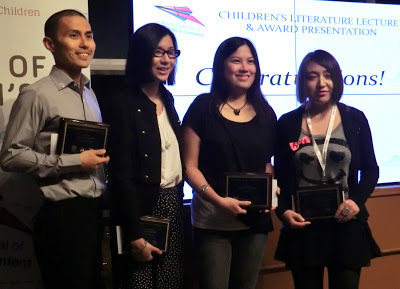 Winners: Author Edmund Lim, Illustrator Tan Zi Xi, Author Debra Chong, Illustrator Bolormaa BaasansurenI was so pleased to see Japan-based Bolormaa Baasansuren of Mongolia win first prize for illustration for her book Old City, and to see her husband shortlisted for the text of this book. Bolormaa had shared a dummy of this book with illustrator John Shelley and me for feedback in 2007 after our workshops in Mongolia.
Winners: Author Edmund Lim, Illustrator Tan Zi Xi, Author Debra Chong, Illustrator Bolormaa BaasansurenI was so pleased to see Japan-based Bolormaa Baasansuren of Mongolia win first prize for illustration for her book Old City, and to see her husband shortlisted for the text of this book. Bolormaa had shared a dummy of this book with illustrator John Shelley and me for feedback in 2007 after our workshops in Mongolia.
 Bolormaa Baasansuren, Rama Ramachadran (Executive Director National Book Development Council of Singapore), Gambaatar IchinnorovHere are some of the Japan folk mobbing congratulating Bolormaa.
Bolormaa Baasansuren, Rama Ramachadran (Executive Director National Book Development Council of Singapore), Gambaatar IchinnorovHere are some of the Japan folk mobbing congratulating Bolormaa.
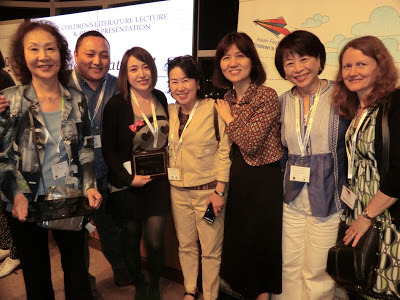 Akiko Sueyoshi, Gambaatar Ichinnorov, Bolormaa Baasansuren, Akiko Beppu, Etsuko Nozawa, Naomi Kojima, Holly ThompsonBetween sessions I checked out and purchased books--from around Asia...
Akiko Sueyoshi, Gambaatar Ichinnorov, Bolormaa Baasansuren, Akiko Beppu, Etsuko Nozawa, Naomi Kojima, Holly ThompsonBetween sessions I checked out and purchased books--from around Asia...
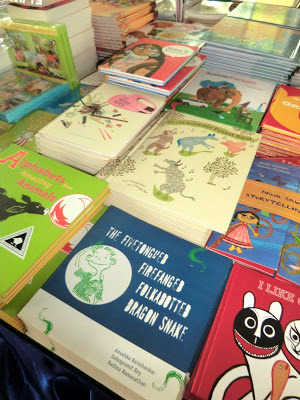 including a copy of Longhouse Days by Jainal Amambing, whose work I'd featured along with Bolormaa Baasansuren's in my article about the Noma Concours in Kyoto Journal, Issue 67, a few years ago.
including a copy of Longhouse Days by Jainal Amambing, whose work I'd featured along with Bolormaa Baasansuren's in my article about the Noma Concours in Kyoto Journal, Issue 67, a few years ago.
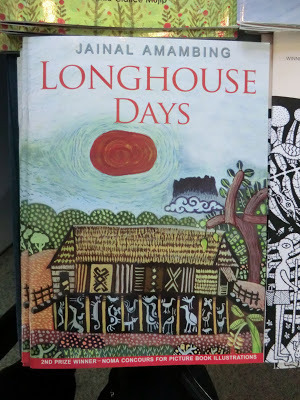 I attended as many sessions as I could during the conference--Challenge, Trauma and Recovery in YA with authors Susanne Gervay and Wendy Orr; Asian-Themed Publishing in the U.S. with Shen's Book publisher Renee Ting; Celebrating Diversity in Children's Picture books with IBBY president Ahmad Khairuddin; Grabbing Your Readers' Attention with authors Candy Gourlay and Kathleen Ahrens. the future of publishing in Digital Space; First Pages critiques; blogging and more.
I attended as many sessions as I could during the conference--Challenge, Trauma and Recovery in YA with authors Susanne Gervay and Wendy Orr; Asian-Themed Publishing in the U.S. with Shen's Book publisher Renee Ting; Celebrating Diversity in Children's Picture books with IBBY president Ahmad Khairuddin; Grabbing Your Readers' Attention with authors Candy Gourlay and Kathleen Ahrens. the future of publishing in Digital Space; First Pages critiques; blogging and more.
 Authors Kathleen Ahrens and Candy GourlayProject Splash! Asia was also celebrated--this features an annotated bibliography of water-themed stories from Asia. They are still collecting titles of stories to grow the bibliography further, so feel free to send them in via PaperTigers.org. The Wakame Gatherers was featured in this list.
Authors Kathleen Ahrens and Candy GourlayProject Splash! Asia was also celebrated--this features an annotated bibliography of water-themed stories from Asia. They are still collecting titles of stories to grow the bibliography further, so feel free to send them in via PaperTigers.org. The Wakame Gatherers was featured in this list.
 The Splash Asia Team
The Splash Asia Team
 Splash Asia books at the National Library SingaporeSCBWI has a major presence each year at AFCC with regional SCBWI teams from around Asia and Oceania plus SCBWI members from regions around the world in attendance.
Splash Asia books at the National Library SingaporeSCBWI has a major presence each year at AFCC with regional SCBWI teams from around Asia and Oceania plus SCBWI members from regions around the world in attendance.
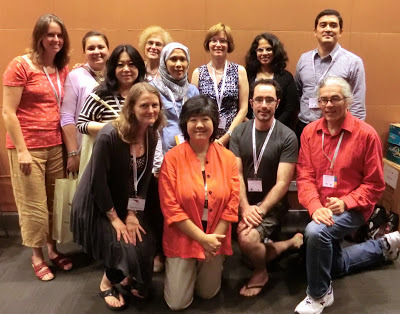 SCBWI Regional Team members from Malaysia, Australia, Japan, Hong Kong, Singapore, Indonesia and IndiaAFCC is as much about the conversations with new and old friends as it is about the sessions and keynotes and special events. Already I'm missing those friends and looking forward to AFCC 2014.
SCBWI Regional Team members from Malaysia, Australia, Japan, Hong Kong, Singapore, Indonesia and IndiaAFCC is as much about the conversations with new and old friends as it is about the sessions and keynotes and special events. Already I'm missing those friends and looking forward to AFCC 2014.
 Attendees from Japan with Mr. Rama Ramachadran
Attendees from Japan with Mr. Rama Ramachadran
 Author and AFCC board member Nury Vittachi, Corinne Robson of PaperTigers and author Candy GourlayAnd I look forward to more salted caramel ice cream. Yes, I had another cup just before my taxi ride to Changi airport.
Author and AFCC board member Nury Vittachi, Corinne Robson of PaperTigers and author Candy GourlayAnd I look forward to more salted caramel ice cream. Yes, I had another cup just before my taxi ride to Changi airport.
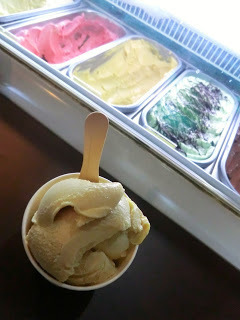
For the first year AFCC was held at the National Library Singapore. That pod way up top, amid flitting swallows, was where a number of events were held and where I gave my keynote talk.

This year I was speaking in the translation seminar, a new track for the conference, on editing stories in translation--reflecting on my experience with the Tomo anthology. This track was organized by translator Avery Fischer Udagawa and also featured Alexander O. Smith--both are Tomo story translators. How nice to meet Tomo fans from around Asia! See the full post on the Tomo blog.
 Tomo fans!The country of focus for AFCC 2013 was Malaysia (2014 will be India), so there was a Malaysia night celebration...
Tomo fans!The country of focus for AFCC 2013 was Malaysia (2014 will be India), so there was a Malaysia night celebration... with some amazing desserts.
with some amazing desserts.
My keynote talk was Stories Set in Asia: Selling Them Overseas, including key questions agents and editors tend to ask.

Not long after the keynote was a launch celebration for The Language Inside outside in the plaza. Thanks to Bookaburra Books of Singapore for handling book sales for all of my books.

On the first evening of the Writers and Illustrators Conference at AFCC, the Singtel Asian Picture Book Awards and the Hedwig Anuar Children's Book Awards were announced.
 Winners: Author Edmund Lim, Illustrator Tan Zi Xi, Author Debra Chong, Illustrator Bolormaa BaasansurenI was so pleased to see Japan-based Bolormaa Baasansuren of Mongolia win first prize for illustration for her book Old City, and to see her husband shortlisted for the text of this book. Bolormaa had shared a dummy of this book with illustrator John Shelley and me for feedback in 2007 after our workshops in Mongolia.
Winners: Author Edmund Lim, Illustrator Tan Zi Xi, Author Debra Chong, Illustrator Bolormaa BaasansurenI was so pleased to see Japan-based Bolormaa Baasansuren of Mongolia win first prize for illustration for her book Old City, and to see her husband shortlisted for the text of this book. Bolormaa had shared a dummy of this book with illustrator John Shelley and me for feedback in 2007 after our workshops in Mongolia. Bolormaa Baasansuren, Rama Ramachadran (Executive Director National Book Development Council of Singapore), Gambaatar IchinnorovHere are some of the Japan folk mobbing congratulating Bolormaa.
Bolormaa Baasansuren, Rama Ramachadran (Executive Director National Book Development Council of Singapore), Gambaatar IchinnorovHere are some of the Japan folk mobbing congratulating Bolormaa. Akiko Sueyoshi, Gambaatar Ichinnorov, Bolormaa Baasansuren, Akiko Beppu, Etsuko Nozawa, Naomi Kojima, Holly ThompsonBetween sessions I checked out and purchased books--from around Asia...
Akiko Sueyoshi, Gambaatar Ichinnorov, Bolormaa Baasansuren, Akiko Beppu, Etsuko Nozawa, Naomi Kojima, Holly ThompsonBetween sessions I checked out and purchased books--from around Asia... including a copy of Longhouse Days by Jainal Amambing, whose work I'd featured along with Bolormaa Baasansuren's in my article about the Noma Concours in Kyoto Journal, Issue 67, a few years ago.
including a copy of Longhouse Days by Jainal Amambing, whose work I'd featured along with Bolormaa Baasansuren's in my article about the Noma Concours in Kyoto Journal, Issue 67, a few years ago. I attended as many sessions as I could during the conference--Challenge, Trauma and Recovery in YA with authors Susanne Gervay and Wendy Orr; Asian-Themed Publishing in the U.S. with Shen's Book publisher Renee Ting; Celebrating Diversity in Children's Picture books with IBBY president Ahmad Khairuddin; Grabbing Your Readers' Attention with authors Candy Gourlay and Kathleen Ahrens. the future of publishing in Digital Space; First Pages critiques; blogging and more.
I attended as many sessions as I could during the conference--Challenge, Trauma and Recovery in YA with authors Susanne Gervay and Wendy Orr; Asian-Themed Publishing in the U.S. with Shen's Book publisher Renee Ting; Celebrating Diversity in Children's Picture books with IBBY president Ahmad Khairuddin; Grabbing Your Readers' Attention with authors Candy Gourlay and Kathleen Ahrens. the future of publishing in Digital Space; First Pages critiques; blogging and more. Authors Kathleen Ahrens and Candy GourlayProject Splash! Asia was also celebrated--this features an annotated bibliography of water-themed stories from Asia. They are still collecting titles of stories to grow the bibliography further, so feel free to send them in via PaperTigers.org. The Wakame Gatherers was featured in this list.
Authors Kathleen Ahrens and Candy GourlayProject Splash! Asia was also celebrated--this features an annotated bibliography of water-themed stories from Asia. They are still collecting titles of stories to grow the bibliography further, so feel free to send them in via PaperTigers.org. The Wakame Gatherers was featured in this list. The Splash Asia Team
The Splash Asia Team
 Splash Asia books at the National Library SingaporeSCBWI has a major presence each year at AFCC with regional SCBWI teams from around Asia and Oceania plus SCBWI members from regions around the world in attendance.
Splash Asia books at the National Library SingaporeSCBWI has a major presence each year at AFCC with regional SCBWI teams from around Asia and Oceania plus SCBWI members from regions around the world in attendance. SCBWI Regional Team members from Malaysia, Australia, Japan, Hong Kong, Singapore, Indonesia and IndiaAFCC is as much about the conversations with new and old friends as it is about the sessions and keynotes and special events. Already I'm missing those friends and looking forward to AFCC 2014.
SCBWI Regional Team members from Malaysia, Australia, Japan, Hong Kong, Singapore, Indonesia and IndiaAFCC is as much about the conversations with new and old friends as it is about the sessions and keynotes and special events. Already I'm missing those friends and looking forward to AFCC 2014. Attendees from Japan with Mr. Rama Ramachadran
Attendees from Japan with Mr. Rama Ramachadran
 Author and AFCC board member Nury Vittachi, Corinne Robson of PaperTigers and author Candy GourlayAnd I look forward to more salted caramel ice cream. Yes, I had another cup just before my taxi ride to Changi airport.
Author and AFCC board member Nury Vittachi, Corinne Robson of PaperTigers and author Candy GourlayAnd I look forward to more salted caramel ice cream. Yes, I had another cup just before my taxi ride to Changi airport.
Published on May 30, 2013 23:42
May 23, 2013
It's Official! Summer Teaching at Grub Street in Boston
It's official--I'll be teaching several classes at Boston's creative writing hub Grub Street on Boylston Street this summer while I'm back in Massachusetts.
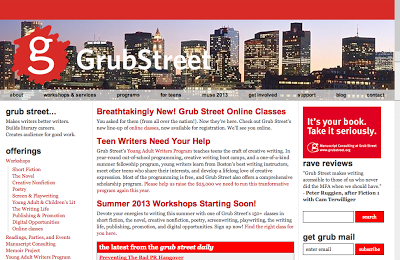
The summer 2013 workshops have now been announced on the Grub website, and I'll be teaching classes in July and August.
Here's what I'll be teaching:
Young Adult Novel Workout Monday-Thursday, 2:30-5:30pm from July 8-11thStory Seeds for Young Adult Writing: Preserving, Sowing and Growing YA Story Ideas Friday, July 12th, 10:30am-1:30pmTackling Novel Revision: Techniques and Tips Friday, August 9th, 10:00am-5:00pmTelling Stories in Verse: An Intro to Narrative Poetry and Verse Novels Friday, August 16th, 10:00am-5:00pmAnd there are lots more workshops offered at Grub Street in Boston this summer--details here. I'm so looking forward to meeting the vibrant Boston writing community.

The summer 2013 workshops have now been announced on the Grub website, and I'll be teaching classes in July and August.
Here's what I'll be teaching:
Young Adult Novel Workout Monday-Thursday, 2:30-5:30pm from July 8-11thStory Seeds for Young Adult Writing: Preserving, Sowing and Growing YA Story Ideas Friday, July 12th, 10:30am-1:30pmTackling Novel Revision: Techniques and Tips Friday, August 9th, 10:00am-5:00pmTelling Stories in Verse: An Intro to Narrative Poetry and Verse Novels Friday, August 16th, 10:00am-5:00pmAnd there are lots more workshops offered at Grub Street in Boston this summer--details here. I'm so looking forward to meeting the vibrant Boston writing community.
Published on May 23, 2013 05:19
May 17, 2013
Happy Book Birthday to Suzanne Kamata, author of Gadget Girl
I've been so excited about this book, having watched it grow over the last few years. Today, fellow SCBWI Japan member, longtime Shikoku resident, and writing friend Suzanne Kamata makes her YA novel debut with Gadget Girl.

Gadget Girl recently was the winner in the young adult category of the 2013 Paris Book Festival annual competition honoring the best of international publishing.
Here is the description of Gadget Girl:
Aiko Cassidy is fifteen, has cerebral palsy, and lives in a small Midwestern town. For most of her life, she has been her sculptor mother’s muse. But now she no longer wants to post for the figures that have made her mother famous. She works on her own dream, becoming a sought-after manga artist with a secret identify. When Aiko’s mother invites her to Paris for a major exhibition, Aiko balks. She’d rather go to Japan, the manga capital of the world. But when she gets to France and meets a hot waiter with a passion for manga, things change.
And some review excerpts:
"Kamata's latest is a sharp, unusual coming-of-age novel...Awkwardly and believably, this sensitive novel reveals an artistic teen adapting to family, disability and friendships in all their flawed beauty." --Kirkus Reviews
"Kamata’s love and intimate knowledge of Paris streets add atmosphere to this smart and surprising coming-of-age story. Readers will feel whisked away by the romance of an artistic life and appreciate the sensitivity and honesty with which Kamata writes about Aiko’s physical and emotional journeys." --Publishers Weekly
Hooray! I'm so pleased that this book will receive some well deserved worldwide attention. Congratulations, Suzanne!

Gadget Girl recently was the winner in the young adult category of the 2013 Paris Book Festival annual competition honoring the best of international publishing.
Here is the description of Gadget Girl:
Aiko Cassidy is fifteen, has cerebral palsy, and lives in a small Midwestern town. For most of her life, she has been her sculptor mother’s muse. But now she no longer wants to post for the figures that have made her mother famous. She works on her own dream, becoming a sought-after manga artist with a secret identify. When Aiko’s mother invites her to Paris for a major exhibition, Aiko balks. She’d rather go to Japan, the manga capital of the world. But when she gets to France and meets a hot waiter with a passion for manga, things change.
And some review excerpts:
"Kamata's latest is a sharp, unusual coming-of-age novel...Awkwardly and believably, this sensitive novel reveals an artistic teen adapting to family, disability and friendships in all their flawed beauty." --Kirkus Reviews
"Kamata’s love and intimate knowledge of Paris streets add atmosphere to this smart and surprising coming-of-age story. Readers will feel whisked away by the romance of an artistic life and appreciate the sensitivity and honesty with which Kamata writes about Aiko’s physical and emotional journeys." --Publishers Weekly
Hooray! I'm so pleased that this book will receive some well deserved worldwide attention. Congratulations, Suzanne!
Published on May 17, 2013 06:00
May 16, 2013
The Language Inside and Inspiration from Poet Julia Tavalaro
When I was a graduate student in the NYU Creative Writing Program in the 1980s, the Goldwater writing workshops at Goldwater Memorial Hospital on Roosevelt Island had recently been launched by poet Sharon Olds, and I signed up as a volunteer in the program. I was terrified. At NYU I was studying as a fiction writer; I was a timid closet poet. I was also squeamish in hospitals and had no experience whatsoever working with the chronically ill or severely disabled.
At Goldwater Hospital, I was first assigned to assist two patients in writing--one a gunshot wound victim writing an autobiographical novel, and another, poet Julia Tavalaro. Julia had had a brain-stem stroke some twenty years prior in 1966 at the age of 32 and had been subsequently paralyzed and locked in. Unable to speak, she’d been assumed to be unresponsive for six years despite efforts by her sister to convince doctors that she was cognizant. A speech therapist finally took the initiative to ask Julia several key questions to which Julia was able to blink in response. From then on, Julia was able to communicate by looking up to indicate yes, and eventually, through very slight head movement, to operate a wheelchair and write with a computer.
With Julia, I used a letter board as instructed, pointing to the columns of letters one by one then running down the letters until she looked up, then writing down the selected letter—this was how she communicated her poems, letter by letter. But I was shy and intimidated, and Julia controlled our conversations. She was bossy and could be mean—once when I called an aide in to help me, Julia spelled the word “stupid.” I know she meant me. I admit I was not very effective working with Julia.
Ultimately I was reassigned to a different patient with a mellower temperament. I felt somewhat defeated but knew that another volunteer and a more accomplished poet might be better suited to working with Julia. I did start speaking up to comment on Julia’s poems in the group workshops, and over time I became bolder at communicating with her when I saw her.
Some years later, through the assistance of poet Richard Tayson, Julia wrote her memoir, Look Up for Yes (Kodansha International, 1997). She was even able to move out of Goldwater Hospital. She lived on with her fierce spirit, writing poems and looking up for yes, until 2003.

Anyone who worked with Julia was profoundly affected by her. She had a fiery determination. She was stubborn. Angry. Crass. Funny. Defiant. Devious. She was unforgettable, and I knew that one day I’d write a story about a girl who works with a brainstem stroke victim. It took me years to finally tackle the story and to take inspiration and courage from Julia to create the character of Zena in my verse novel The Language Inside, in which Emma, a high school student raised in Japan, finds herself volunteering at a long-term care center in Massachusetts assisting Zena in writing her poems.
In writing The Language Inside, I knew that the poems Zena and Emma created, as well as the letter board conversations, would be central to the story. In addition to writing the entire novel in verse, I had to write poems in Zena’s voice, in Emma’s voice, and in the voice of Samnang, the Cambodian-American volunteer assisting Cambodian elders in the long-term care center. The poems they discussed in their writing sessions would also be important to the story. The novel became infused with poetry. Poetry impacted the action of the characters and the action fed the poems the characters wrote.
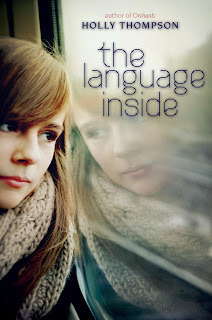
Now, some 25 years after I first met Julia Tavalaro, my novel The Language Inside (Delacorte/Random House, May 2013) has just published. Now that I am older and not quite so “stupid” (I hope), how I wish I could share the news with Julia. I know she’d have something wry to spell out to me—probably along the lines of “What took you so long?”
Thank you, Sharon Olds, for leading the unforgettable workshops at Goldwater Hospital.
And thank you, Julia Tavalaro, for showing me what perseverance really means.
The below excerpt is from “Poem in Mind” by Julia Tavalaro (printed in Look Up for Yes by Julia Tavalaro and Richard Tayson)
Poem in Mind
Take this poem homeRead it no feed it to the mindThe mind fabulously famishedThe mind oh so hungry
**********
Published on May 16, 2013 04:00
May 15, 2013
Birthday Party for The Language Inside in Jeju, Korea
Today was the book birthday party for my verse novel The Language Inside, published by Delacorte/Random House in New York yesterday. It was such a pleasure to celebrate the launch of The Language Inside, which blends elements of U.S., Japanese and Cambodian culture, at the Korean international branch of a Canadian School, Branksome Hall Asia, on Jeju Island, Korea. What a perfectly cross-cultural celebration!
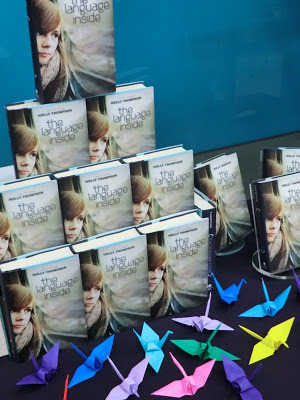
Branksome Hall Asia librarian Brian Farrell did a beautiful job organizing. At the event I introduced the characters and basic story of The Language Inside, read a passage, shared some Cambodian dance video footage, blew out candles on a congratulatory red velvet cake, and held a giveaway of copies of Orchards and The Language Inside, as well as a goods from MC Emma's Japan hometown of Kamakura.
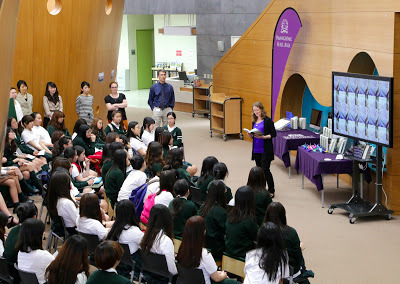 photo by Brian Farrell
photo by Brian Farrell photo by Brian Farrell
photo by Brian Farrell
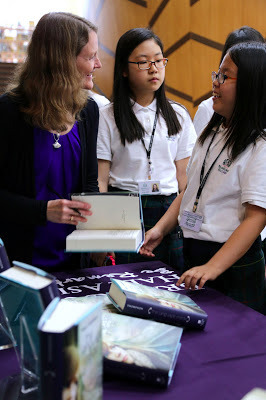 photo by Brian FarrellThere were student interviews and unforgettable conversations with young authors.
photo by Brian FarrellThere were student interviews and unforgettable conversations with young authors. 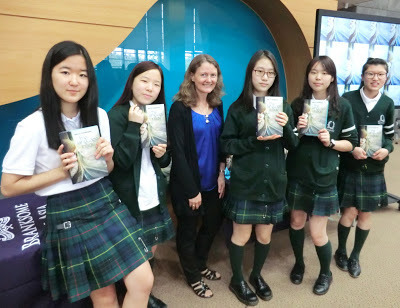
And one of my favorite comments today came from an adult reader who said that the romance in The Language Inside tugged at her emotions and made her want to start dating all over again.

Thank you to Branksome Hall Asia for a perfect book birthday celebration!
Published on May 15, 2013 05:03
May 13, 2013
Launch! The Language Inside
Today is publication day for my verse novel The Language Inside!
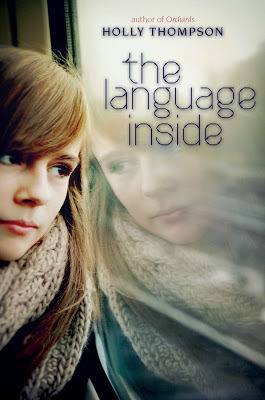
And if you live in the U.S. there is still time to sign up for the Goodreads giveaway on The Language Inside.
And if you live outside the U.S., leave a comment below for a chance to win a copy of The Language Inside. I will do a random drawing on June 1 and post the names of the two winners in a blog post that day. Don't forget to check back on this blog on June 1 in case you are a winner!
Thank you to editor Francoise Bui for her wisdom and guidance in shaping this story. Thank you also to editor Rebecca Short for guiding this book into the world. Thank you to my agent Jamie Weiss Chilton. And thank you to everyone who inspired me along the way.
Happy dancing!

And if you live in the U.S. there is still time to sign up for the Goodreads giveaway on The Language Inside.
And if you live outside the U.S., leave a comment below for a chance to win a copy of The Language Inside. I will do a random drawing on June 1 and post the names of the two winners in a blog post that day. Don't forget to check back on this blog on June 1 in case you are a winner!
Thank you to editor Francoise Bui for her wisdom and guidance in shaping this story. Thank you also to editor Rebecca Short for guiding this book into the world. Thank you to my agent Jamie Weiss Chilton. And thank you to everyone who inspired me along the way.
Happy dancing!
Published on May 13, 2013 21:07
COETAIL: Multitasking and Swatting at Distractions
A post toward obtaining my Certificate in Educational Technology and Information Literacy (COETAIL)
I've become increasingly aware of the effect of multitasking on my own creativity, and over the last year have had to take initiatives to better compartmentalize my time. Online obligations have increased--blogging, tweeting, mounds of emails and more--and the net result is a decrease in writing time and a lack of focus.
When I write I'm generally online since I use a dictionary, thesaurus, and other web tools often conduct internet searches related to my writing. If I happen to notice that an email has come in, or someone mentioned me in a tweet, or messaged me on Facebook, my concentration is shattered. It then takes more energy for me to refocus on my writing, and my days seem to be less and less productive.
I've been concerned about this multitasking lifestyle affecting my concentration, and have also suspected that multitasking has been gradually interfering with abilities of students to concentrate on the basic focused tasks of reading and writing. Schools where students use laptops and devices in nearly all their classes are dealing with this multitasking dilemma all the time.
In "How Does Multitasking Change the Way Kids Learn" Annie Murphy Paul takes a look at studies on media multitasking while learning, citing various studies and discussing at length various negative effects of multitasking while doing schoolwork. Psychology professor David Meyer mentions the possibility that we may be raising shallow learners, and psychology professor Larry Rosen advises keeping only one computer window open when doing schoolwork and taking tech breaks to satisfy tech cravings.
Parents and teachers can try, but this is much harder than it sounds. It's not a simple matter of closing windows or tabs. Schoolwork these days often requires more than one window to be open, sometimes many. Much schoolwork is collaborative, handled on Facebook, Skype, Twitter, and various Google Apps. Distractions slip in, like mosquitoes through the mesh of a window screen, and you know how it is--there's always one still buzzing around.
[image error]
NPR recently aired The Myth of Multitasking and discussed the effect of multitasking on creativity and concentration and the idea that our brains actually need to be retrained once we've been heavily multitasking, and that it's healthy for the brain to multitasking doing integrative things but not nonintegrative things. There are many articles in the news these days on this topic.
So how can we help eliminate these distractions for students? Sharing the results of studies citied in Paul's article and other research with parents, teachers and students is a good start. Recognizing that we need to counteract the distractions by providing much more structure for focusing on tasks like reading and writing is another.
I've become increasingly aware of the effect of multitasking on my own creativity, and over the last year have had to take initiatives to better compartmentalize my time. Online obligations have increased--blogging, tweeting, mounds of emails and more--and the net result is a decrease in writing time and a lack of focus.
When I write I'm generally online since I use a dictionary, thesaurus, and other web tools often conduct internet searches related to my writing. If I happen to notice that an email has come in, or someone mentioned me in a tweet, or messaged me on Facebook, my concentration is shattered. It then takes more energy for me to refocus on my writing, and my days seem to be less and less productive.
I've been concerned about this multitasking lifestyle affecting my concentration, and have also suspected that multitasking has been gradually interfering with abilities of students to concentrate on the basic focused tasks of reading and writing. Schools where students use laptops and devices in nearly all their classes are dealing with this multitasking dilemma all the time.
In "How Does Multitasking Change the Way Kids Learn" Annie Murphy Paul takes a look at studies on media multitasking while learning, citing various studies and discussing at length various negative effects of multitasking while doing schoolwork. Psychology professor David Meyer mentions the possibility that we may be raising shallow learners, and psychology professor Larry Rosen advises keeping only one computer window open when doing schoolwork and taking tech breaks to satisfy tech cravings.
Parents and teachers can try, but this is much harder than it sounds. It's not a simple matter of closing windows or tabs. Schoolwork these days often requires more than one window to be open, sometimes many. Much schoolwork is collaborative, handled on Facebook, Skype, Twitter, and various Google Apps. Distractions slip in, like mosquitoes through the mesh of a window screen, and you know how it is--there's always one still buzzing around.
[image error]
NPR recently aired The Myth of Multitasking and discussed the effect of multitasking on creativity and concentration and the idea that our brains actually need to be retrained once we've been heavily multitasking, and that it's healthy for the brain to multitasking doing integrative things but not nonintegrative things. There are many articles in the news these days on this topic.
So how can we help eliminate these distractions for students? Sharing the results of studies citied in Paul's article and other research with parents, teachers and students is a good start. Recognizing that we need to counteract the distractions by providing much more structure for focusing on tasks like reading and writing is another.
Published on May 13, 2013 08:34
May 12, 2013
Jeju Island School Visits--Books and Lava
I've been lucky to be invited to Jeju Island in South Korea for author visits at two schools. Last week I enjoyed two days of sessions with middle and high school students at the North London Collegiate School. And this coming week I'll have four days at Branksome Hall Asia. Both international schools are part of the new Global Education City here on volcanic Jeju Island, .
At NLCS, I enjoyed all the questions from the astute students, mostly Korean but not from Jeju, and many of them boarding students. My last session on Friday afternoon was with student editors of a school magazine. At the end of the "press conference" in which a team of students asked me questions about writing books, creativity, biculturalism and bilingualism, Japan and much much more... I turned the questions to them--what kind of book should I write next? what do they want to read? And one boy said, "I think you should write a book with Korea, Japan and the U.S. in it. That's what I'd like to read." Whoa--tall order!
This weekend, thanks to one of the librarians, I had a car for exploring the island.
I started out with Seongsan Ichulbong or Sunrise Peak in the east, a rocky tuff cone with a lush green crater off a little peninsula.

And I explored back roads, loving the seaside agricultural villages and the lava rock walls.

I found plenty of seaweed drying (a variety of Gelidium/tengusa) taking place.
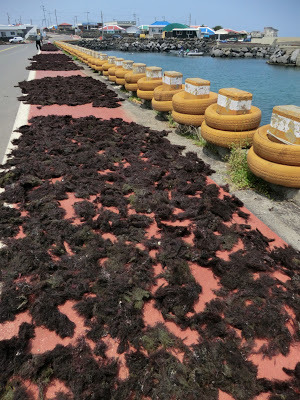
And I walked through a stretch of the incredible seven-kilometer Manjangul lava tube, drippy, dark and cool. I learned about lava shelves, lava rafts, lava columns and lava toes. (Do you suppose they can wriggle?)
This morning I rose with the sun and was on the Yeongsil hiking trail to Mt. Halla (highest mountain in Korea) by 7:15. It was a perfect day, and the trails were blissfully quiet until midday. Some stretches had wooden boardwalks; other sections were over paths of lava rock.
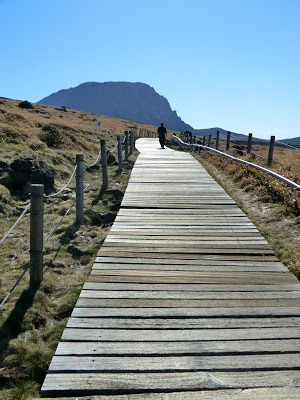
The views over the alpine landscape as well as the distant views of oreum (small volcanic mountains) were incredible.

The Yeongsil course leads up to Witse Oreum at 1,700 meters.
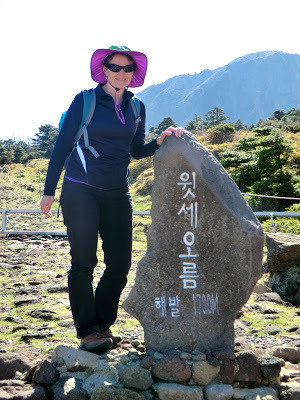
Then I hiked further through sasa terrain with huge lava rocks and here and there some roe deer...
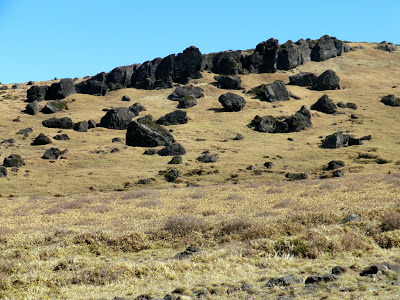
and azalea slopes.
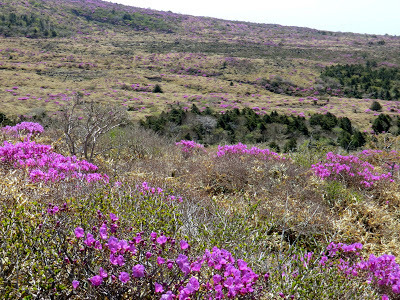
The hike ended at a point with spectacular views of the summit of Mt. Halla, which is accessible only from the longer trails on the other side of the mountain.

In the afternoon after the hike down, I went over to the Hallim area on the west coast, for more dramatic scenery.

Jeju Island is certainly deserving of World Heritage Site status. I look forward to the rest of my stay and hope to return again for more hikes and exploration.
At NLCS, I enjoyed all the questions from the astute students, mostly Korean but not from Jeju, and many of them boarding students. My last session on Friday afternoon was with student editors of a school magazine. At the end of the "press conference" in which a team of students asked me questions about writing books, creativity, biculturalism and bilingualism, Japan and much much more... I turned the questions to them--what kind of book should I write next? what do they want to read? And one boy said, "I think you should write a book with Korea, Japan and the U.S. in it. That's what I'd like to read." Whoa--tall order!
This weekend, thanks to one of the librarians, I had a car for exploring the island.
I started out with Seongsan Ichulbong or Sunrise Peak in the east, a rocky tuff cone with a lush green crater off a little peninsula.

And I explored back roads, loving the seaside agricultural villages and the lava rock walls.

I found plenty of seaweed drying (a variety of Gelidium/tengusa) taking place.

And I walked through a stretch of the incredible seven-kilometer Manjangul lava tube, drippy, dark and cool. I learned about lava shelves, lava rafts, lava columns and lava toes. (Do you suppose they can wriggle?)
This morning I rose with the sun and was on the Yeongsil hiking trail to Mt. Halla (highest mountain in Korea) by 7:15. It was a perfect day, and the trails were blissfully quiet until midday. Some stretches had wooden boardwalks; other sections were over paths of lava rock.

The views over the alpine landscape as well as the distant views of oreum (small volcanic mountains) were incredible.

The Yeongsil course leads up to Witse Oreum at 1,700 meters.

Then I hiked further through sasa terrain with huge lava rocks and here and there some roe deer...

and azalea slopes.

The hike ended at a point with spectacular views of the summit of Mt. Halla, which is accessible only from the longer trails on the other side of the mountain.

In the afternoon after the hike down, I went over to the Hallim area on the west coast, for more dramatic scenery.

Jeju Island is certainly deserving of World Heritage Site status. I look forward to the rest of my stay and hope to return again for more hikes and exploration.
Published on May 12, 2013 06:53
May 6, 2013
Artists, Guts and Student Creative Writing
A post toward obtaining my Certificate in Educational Technology and Information Literacy (COETAIL)
In our COETAIL Course 2 class today, we'll be focusing on digital footprints, but I've been mulling a video from our last class. Seth Godin in the 2011 PressPausePlay interview "The Creative Field" says that industry gatekeepers are under stress these days, that anyone can create art now. Godin says that we are broadening our idea of art these days, and his definition of art is that it is generous, that you're not doing it just to make a profit; that it's new, original and real; and it has to make a change in the person you're presenting your work to.
As Godin goes on to say, artists can more easily go directly to their market these days, but is this all good? The interview weighs the advantages and disadvantages to such a system. And he points out that today you either have to become a marketer or partner with one. I sense that most writers and other artists inevitably do both, market and partner with marketers.
Godin adds that it's easy to get your work out to followers at least a certain number of followers these days. But the trick is coming up with work that people will care about. "Art is about doing work that people choose to talk about," Godin says. As an artist you have to decide who you're trying to change. You have to have the guts to do something different, he says.
So how does this relate to teachers in the arts? Teachers of creative writing? What will students need going forward to help them stand apart from a field saturated with "amateurs"? How do we as teachers get students to go the distance to have the guts to do something different that will rise above other work?
When I'm teaching, children, teens, university students, adults, I often encounter timid writing. Bland poems. Dull stories that don't take risks. And sometimes I'm frustrated that student peers or other teachers seem satisfied with this timid, safe writing. Sometimes I feel that in school, when we don't give students enough time to create on their own, we are enabling timid writing. In poetry classes, students are often not encouraged to revise much, to take their poems as far as they can go. Or poetry is given over to annotation and analysis.
I love to share Billy Collins' poem Introduction to Poetry.
Students need time to go into their own creative zone to discover their artistic "guts" for a writing project, and this focus can easily get lost in the logistics of a school day and the social and collaborative aspects of the classroom.
Ideally creative writing classrooms and writing groups encourage artistic risk-taking, while at the same time offering guidance about what is realistically "marketable" to others--meaningful, impactful work, work that people will want to talk about. But too much emphasis on marketing while creating can lead to stifled art. Sometimes we need to forget the audience to do our best work.
Creative writing students today can exchange ideas and find audiences via blogs, YouTube, and other social media. Students can easily listen to poets reading online and watch performance poetry. They can access flash fiction, short stories, literary journals, multimedia writing, and all sorts of writing online. Within and beyond their own libraries, there are models of inspiration everywhere. They can try NaNoWriMo or join Camp NaNoWriMo and try writing a novel in a month.
To encourage students to write with guts, I try to share examples of poetry and fiction that reveal courage and originality, that include characters and voices that we haven't met before. I share my own work--both my timid, unsatisfying writing, and bolder writing that readers react to.
I also try to share my process. Students will find their own "guts" if they can better see and understand the creative process, the way we start from a fragile seed that we nurture into what is often a withering mess, and how we then try to summon the courage to tackle that mess and cultivate it into art--of the sort worth talking about. We hope.
In our COETAIL Course 2 class today, we'll be focusing on digital footprints, but I've been mulling a video from our last class. Seth Godin in the 2011 PressPausePlay interview "The Creative Field" says that industry gatekeepers are under stress these days, that anyone can create art now. Godin says that we are broadening our idea of art these days, and his definition of art is that it is generous, that you're not doing it just to make a profit; that it's new, original and real; and it has to make a change in the person you're presenting your work to.
As Godin goes on to say, artists can more easily go directly to their market these days, but is this all good? The interview weighs the advantages and disadvantages to such a system. And he points out that today you either have to become a marketer or partner with one. I sense that most writers and other artists inevitably do both, market and partner with marketers.
Godin adds that it's easy to get your work out to followers at least a certain number of followers these days. But the trick is coming up with work that people will care about. "Art is about doing work that people choose to talk about," Godin says. As an artist you have to decide who you're trying to change. You have to have the guts to do something different, he says.
So how does this relate to teachers in the arts? Teachers of creative writing? What will students need going forward to help them stand apart from a field saturated with "amateurs"? How do we as teachers get students to go the distance to have the guts to do something different that will rise above other work?
When I'm teaching, children, teens, university students, adults, I often encounter timid writing. Bland poems. Dull stories that don't take risks. And sometimes I'm frustrated that student peers or other teachers seem satisfied with this timid, safe writing. Sometimes I feel that in school, when we don't give students enough time to create on their own, we are enabling timid writing. In poetry classes, students are often not encouraged to revise much, to take their poems as far as they can go. Or poetry is given over to annotation and analysis.
I love to share Billy Collins' poem Introduction to Poetry.
Students need time to go into their own creative zone to discover their artistic "guts" for a writing project, and this focus can easily get lost in the logistics of a school day and the social and collaborative aspects of the classroom.
Ideally creative writing classrooms and writing groups encourage artistic risk-taking, while at the same time offering guidance about what is realistically "marketable" to others--meaningful, impactful work, work that people will want to talk about. But too much emphasis on marketing while creating can lead to stifled art. Sometimes we need to forget the audience to do our best work.
Creative writing students today can exchange ideas and find audiences via blogs, YouTube, and other social media. Students can easily listen to poets reading online and watch performance poetry. They can access flash fiction, short stories, literary journals, multimedia writing, and all sorts of writing online. Within and beyond their own libraries, there are models of inspiration everywhere. They can try NaNoWriMo or join Camp NaNoWriMo and try writing a novel in a month.
To encourage students to write with guts, I try to share examples of poetry and fiction that reveal courage and originality, that include characters and voices that we haven't met before. I share my own work--both my timid, unsatisfying writing, and bolder writing that readers react to.
I also try to share my process. Students will find their own "guts" if they can better see and understand the creative process, the way we start from a fragile seed that we nurture into what is often a withering mess, and how we then try to summon the courage to tackle that mess and cultivate it into art--of the sort worth talking about. We hope.
Published on May 06, 2013 22:51



